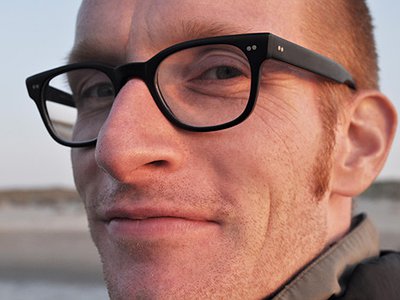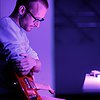When did you start writing/producing music - and what or who were your early passions and influences?
I started writing my own songs about twelve years ago I guess. That was guitar based stuff, and nothing serious. I played in a doom metal band for a few months, and I wrote some songs for the band then. But the first seeds of what became Machinefabriek were in my parents’ attic, where I used a super simple software program to create my own music, very much inspired by drum ‘n bass and trip hop.
Although probably not apparent in my music now, the first music I really felt passionate about was death metal. Stuff like Carcass, Morbid Angel, Death, etc. I was a really shy kid, and surprised a lot of people with my musical taste I think.
Soon after metal, Warp took over, Autechre, Two Lone Swordsmen, Aphex Twin, etc.
When I work on music nowadays, I think my biggest influence lies in improvised, lower case music. Stuff that’s released on labels like Erstwhile, Potlach, Another Timbre, etc. I think the most interesting music is made in that field.
What do you personally consider to be the incisive moments in your artistic work and/or career?
My first solo performance, in De Onderbroek in Nijmegen. I can hardly bear to listen to the recording of it, but the moment was of extreme importance. It was the first time I experienced being on stage by myself. It was nerve wracking, and it still is a lot of the time, but it gave me a lot of confidence.
Another moment, or rather a period, was my project with Stephen Vitiello for ‘Box Music’, especially the live performance we did for the Send+Receive festival in Canada. We both compiled a box with all kinds of non musical objects and handed them to each other when the performance started. We unwrapped the boxes and discovered what was in there on stage, and had to improvise with it without any prior practice. It was really exhilarating and liberating.
Music Box in Montreal
What are currently your main compositional- and production-challenges?
I think right now, my ‘holy grail’ is searching for something super minimal and even more pure. That ‘purity’ is not something I can easily explain, but the more sounds are processed and filtered, the less honest it seems. I think I want to make electronic music that doesn’t sound artificial. That’s also why I’m so attracted to the before mentioned lowercase (sorry for the term) improv musicians. They mostly just use one instrument, and make their otherworldly sounds without pos-production. I’m not able to play an instrument that way, so I’m trying to at least get close to this purity with making electronic music.
A good example is also the label Entr’acte. I think they nailed it. The stuff they release seems to have that ‘x-factor’ that I’m looking for myself.
I guess the challenge is to do less, not to do more.
Right now I’m working on a collaboration with Philippe Petit, which is the opposite of what I just described. It's noisy, stuffed with sounds, more maximalist than minimalist… So you see, I’m not that steadfast.
What do you usually start with when working on a new piece?
It depends if it’s a commission or not. If it’s a commission, most of the time there’s already a concept my piece has to relate to, so that might help my thought process. But pure production wise, I just start. Most of the time I start with one sound, the beginning of the piece, and I don’t know how the rest of the piece will be. It will take shape as I work on it. This is a working method I very much enjoy, keeping things open to surprise myself and to not be too restricted about what will happen.
How strictly do you separate improvising and composing?
Not so much. I think my compositions can be seen as improvisations. Like I explained with the previous answer, pieces exist as I work on them, and they're lead by what I hear. So it’s very intuitive, and ‘in the moment’. In the end, a piece can be seen as a recorded, polished - but not to much- improvisation.
This process of improvisation comes much more to the fore when performing live. Then, it all happens in the moment, without a plan. It seems that the less prepared I am, the better it goes. This can be quite an overwhelming experience, which I highly enjoy. But of course it doesn’t always go like I want it to, and then performing can be a pain in the arse.
How do you see the relationship between sound, space and composition?
If you don’t mind I'll change the word ‘composition’ to ‘music’. The aspect of sound relating to a space is specifically apparent when performing live. I see my performances as a dialogue with the room I’m playing in. The acoustics, the sound system, and the atmosphere are important influences in how a piece will develop. How the sound behaves in a room will dictate my next move.
I also find it very interesting that music sounds different on each system you play it on, and in each room it's played in. So everyone hears a slightly different version of what I heard when making the music.
I made a few site specific installations. That’s really one of my favourite things to do. You get the most out of a space, and out of the sounds you create for it. Things can be shaped to a perfect situation, a totally immersive experience.
Two examples of my site specific works are the Windtunnel recorded for the NAi and the Kamermuziek commissioned by the Stedelijk Museum.
Interviews / About
Fifteen Questions with Machinefabriek's Rutger Zuydervelt
Visual flirtations
Up in the attic
Dutch graphic designer Rutger Zuydervelt is known to most people by another name and with another professional association. Known as Machinefabriek, Zuydervelt is well established in the independent music scene for his minimal, ambient electronic music. Prolific and grounded, Zuydervelt has never fully let go of his visual roots and collaborates often with many artists and artistic institutions. He has provided soundtracks for short films, documentaries and installations and designs and produce his own album art work. Looking for musical thrills and not bothered by his own aesthetic contradictions, Zuydervelt's draws from his deep creative well and continues to make music in uncertain terrain.

I was a really shy kid, and surprised a lot of people with my musical taste I think.

Content
About
Dutch graphic designer Rutger Zuydervelt is known to most people by another name and with another professional association. Known as Machinefabriek, Zuydervelt is well established in the independent music scene for his minimal, ambient electronic music. Prolific and grounded, Zuydervelt has never fully let go of his visual roots and collaborates often with many artists and artistic institutions. He has provided soundtracks for short films, documentaries and installations and designs and produce his own album art work. Looking for musical thrills and not bothered by his own aesthetic contradictions, Zuydervelt's draws from his deep creative well and continues to make music in uncertain terrain.Video
Links
- Ellipsis:
https://vimeo.com/25619503

